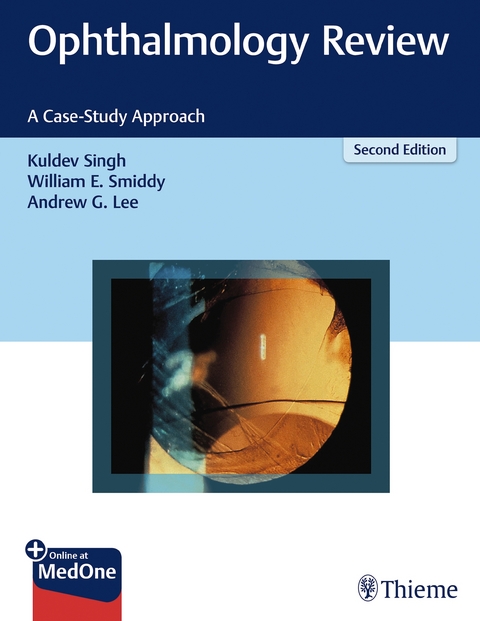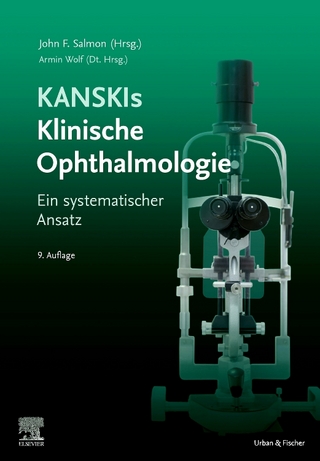
Ophthalmology Review
Thieme (Verlag)
978-1-62623-176-4 (ISBN)
- Hundreds of tables, full-color images, and line drawings enhance clinical understanding
- Presents patient management problems, focusing on diagnosis, problem-solving, and treatment
- Disorders of the retina such as diabetic retinopathy, retinal vein and artery occlusion, AMD, myopic degeneration, chorioretinopathy, vitreous hemorrhage, and retinitis pigmentosa
- Neuro-ophthalmologic conditions including optic neuritis, various types of nerve palsy, internuclear ophthalmoplegia, and anisocoria
- Pediatric eye conditions — from leukocoria and torticollis — to optic nerve hypoplasia
Ophthalmology Review: A Case-Study Approach, Second Edition by renowned experts Kuldev Singh, William Smiddy, and Andrew Lee is a practical, case-based reference covering a wide array of common to serious ophthalmic conditions encountered in daily practice.
The new edition reflects significant advances in ophthalmologic surgery and additional quick-reference material. The focus is on patient management problems and how to handle them and optimally manage the patient. A cadre of esteemed contributors discuss diagnostic methods, evaluation, contraindications, and patient management issues for a full spectrum of clinical disorders, with significant clinical pearls gleaned from hands-on expertise.
A full spectrum of subspecialties are reflected in nearly 100 ophthalmology cases presented in 11 sections, encompassing the cornea and external disease, lens, glaucoma, retina, uveitis, tumors, posterior segment complications, ocular trauma, neuro-ophthalmology, pediatrics, and oculoplastic surgery. Each succinct case walks readers step by step through patient history, the examination, differential diagnoses, test interpretation, definitive diagnosis, medical and/or surgical management, rehabilitation, and follow up, with handy key point summaries.
This is an essential exam review resource for ophthalmology residents... Its systematic approach provides an ideal teaching tool for ophthalmologists to use in courses and grand rounds.
Kuldev Singh, MD, is Professor of Ophthalmology at the Stanford University Medical Center.
Andrew G. Lee, MD, Chair of the Blanton Eye Institute at Houston Methodist Hospital and Professor of Ophthalmology, Neurology, and Neurosurgery at the Weill Cornell Medical College.
1 Acute Follicular Conjunctivitis
2 Chronic Follicular Conjunctivitis
3 Acute Bacterial Conjunctivitis
4 Pterygium
5 Recurrent Erosion/Epithelial Basement Membrane Dystrophy
6 Fuchs' Corneal Dystrophy
7 Keratoconus
8 Microbial Keratitis
9 Keratoconjunctivitis Sicca-Dry Eye
10 Postsurgical Corneal Edema
11 Dellen
12 Graft Rejection Following Penetrating Keratoplasty
13 Blepharitis
14 A Nearly Mature Cataract in a Patient with Glaucoma
15 Retained Lens Material after Cataract Extraction
16 Fibrin Deposition on Intraocular Lenses
17 Subluxated Crystalline Lens
18 Congenital Cataract
19 Ocular Hypertension
20 Open-Angle Glaucoma
21 Primary Angle-Closure Glaucoma
22 Pigmentary Glaucoma
23 Neovascular Glaucoma
24 Inflammatory Glaucoma
25 Primary Congenital Glaucoma
26 Ocular Hypotony
27 PosttrabeculectomyWound Leak
28 Failing Filtering Bleb
29 Flat Anterior Chamber
30 Persistent Choroidal Detachment
31 Nonproliferative Diabetic Retinopathy
32 Diabetic Macular Edema
33 Proliferative Diabetic Retinopathy
34 Retinal Arterial Occlusion
35 Central Retinal Vein Occlusion
36 Branch Retinal Vein Occlusion
37 Nonexudative Age-Related Macular Degeneration
38 Exudative Age-Related Macular Degeneration
39 Myopic Degeneration
40 Idiopathic Central Serous Chorioretinopathy
41 Epiretinal Membrane
42 Vitreomacular Traction
43 Vitreous Hemorrhage
44 Retinitis Pigmentosa
45 Choroiditis
46 Retinitis
47 The White Dot Syndromes
48 Vascular Tumor
49 Choroidal Melanoma
50 Dislocated Posterior Chamber Intraocular Lens
51 Cystoid Macular Edema
52 Endophthalmitis
53 Suprachoroidal Hemorrhage
54 Ruptured Globe
55 Intraocular Foreign Body
56 Optic Neuritis
57 Optic Disc Edema with Macular Star (Neuroretinitis)
58 Anterior Ischemic Optic Neuropathy-Nonarteritic
59 Anterior Ischemic Optic Neuropathy-Arteritic
60 Progressive Optic Neuropathy-Tumor
61 Papilledema-Pseudotumor Cerebri
62 Visual Field Defect-Junctional Scotoma
63 Visual Field Defect-Pituitary Lesion
64 Visual Field Defect-Homonymous Hemianopia
65 Transient Monocular Visual Loss
66 Third Nerve Palsy-Ischemic
67 Third Nerve Palsy-Aneurysm
68 Fourth Nerve Palsy-Congenital
69 Sixth Nerve Palsy
70 Internuclear Ophthalmoplegia
71 Diplopia-Ocular Myasthenia Gravis
72 Thyroid Ophthalmopathy
73 Anisocoria-Tonic Pupil
74 Anisocoria-Horner's Syndrome
75 Anisocoria-Eye Drops
76 Leukocoria
77 The Child Who Sees Poorly Out of One Eye
78 Childhood Torticollis
79 Aniridia
80 Retinopathy of Prematurity
81 Childhood Esotropia
82 Childhood Exotropia
83 Childhood Ptosis
84 The Apparently Blind Infant
85 Optic Nerve Hypoplasia
86 Ptosis
87 Thyroid Eye Disease
88 Ectropion
89 Entropion
90 Trichiasis
91 Dacryocystitis
92 Idiopathic Orbital Inflammation
93 Orbital Cellulitis
94 Dacryoadenitis
95 Orbital Tumors of Childhood
96 Orbital Tumors in Adults
97 Benign Tumors of the Eyelid
98 Malignant Tumors of the Eyelid
| Erscheinungsdatum | 21.07.2017 |
|---|---|
| Zusatzinfo | 223 Abbildungen |
| Verlagsort | New York |
| Sprache | englisch |
| Maße | 254 x 178 mm |
| Gewicht | 1 g |
| Einbandart | kartoniert |
| Themenwelt | Medizin / Pharmazie ► Medizinische Fachgebiete ► Augenheilkunde |
| Medizin / Pharmazie ► Studium | |
| Schlagworte | Augenheilkunde / Ophtalmologie |
| ISBN-10 | 1-62623-176-1 / 1626231761 |
| ISBN-13 | 978-1-62623-176-4 / 9781626231764 |
| Zustand | Neuware |
| Informationen gemäß Produktsicherheitsverordnung (GPSR) | |
| Haben Sie eine Frage zum Produkt? |
aus dem Bereich


